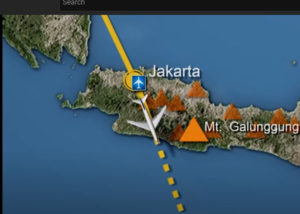
British Airways Boeing 747 flying into a volcanic ash cloud
What does a pilot say when he thinks he is going to crash?
On 24 June 1982, a British Airways Boeing 747, flying from Kuala Lumpur to Perth encountered volcanic ash from the eruption of Mount Galunggung in Indonesia. It caused all the 4 engines to shut down.
Captain Moody followed the mantra as what most professional pilots would do, “aviate, navigate, communicate”.
Having 4 engines failed on a Jumbo jet was extremely rare. He had to “aviate” or fly the plane, then “navigate” or divert to a suitable airport.
Even with all engine dead, a plane would not drop off the sky. She is capable of gliding in the air. As such, the flight crew quickly calculated that the 747 could glide for 23 minutes from 37.000 feet to a distance of 169 kilometers, good for a landing at Jakarta.
Next, he had to ‘communicate’ to keep everyone informed.
To aid pilot’s memory, the mnemonics ‘CCCCC’ were coined.
First ‘C’ is to ensure that the cockpit ‘CREW’ be informed of the emergency.
Second ‘C’ is to communicate with the air traffic ‘CONTROLLER’ and to declare a MAYDAY (distress) call.
Third ‘C’ is to communicate to the ‘CABIN CREW’ on the nature of the emergency; whether an evacuation was required; how it would be communicated; time to impact or any special instructions.
Fourth ‘C’ is to keep ‘CUSTOMERS’ informed.
Here is one classic example of “What does a pilot say when he thinks he is going to crash?”
When British Airways Flight 9 lost all its engines, Captain Moody calmly announced,
”Ladies and gentlemen, this is your captain speaking. We have a small problem. All four engines have stopped. We are doing our damnedest to get them going again. I trust you are not in too much distress.”
This announcement has been described as “a masterpiece of understatement”
Yes, Captain Moody and his crew did their utmost. He “navigated” and turned towards the nearest alternate Halim Airport in Jakarta.
Without any engines, the 747’s glide ratio is about 15:1, meaning it could glide 2.5 nautical miles or 4.6 kilometers for every 1000 feet lost. During the glide, attempts to restart the 4 engines failed until they were at a lower altitude where all their 4 engines were revived.
However, one engine was later shut down as it was giving some problems. Thankfully, they made a successful landing on 3 engines!
During the emergency, some passengers, fearing for their lives even wrote goodbye messages. One scrawled, “Ma, in trouble. Plane going down. Will do best for boys. We love you. Sorry. Pa XXX” on the cover of his ticket wallet.
Finally, the fifth ‘C’ was to keep the ‘COMPANY’ informed.
In the 747 case, the captain had 23 minutes to handle the emergency and so he had some time to slip in a short announcement.
However, not many had the luxury of time. In one mid-air collision between a Boeing 727 and a light Cessna plane over San Francisco, the last poignant message by the captain was, “This is it! Brace yourself! Mom, I love you!” before it crashed.
See a YouTube video on
“Did a Volcanic Eruption Cause BA Flight 09’s Engines to Fail?”